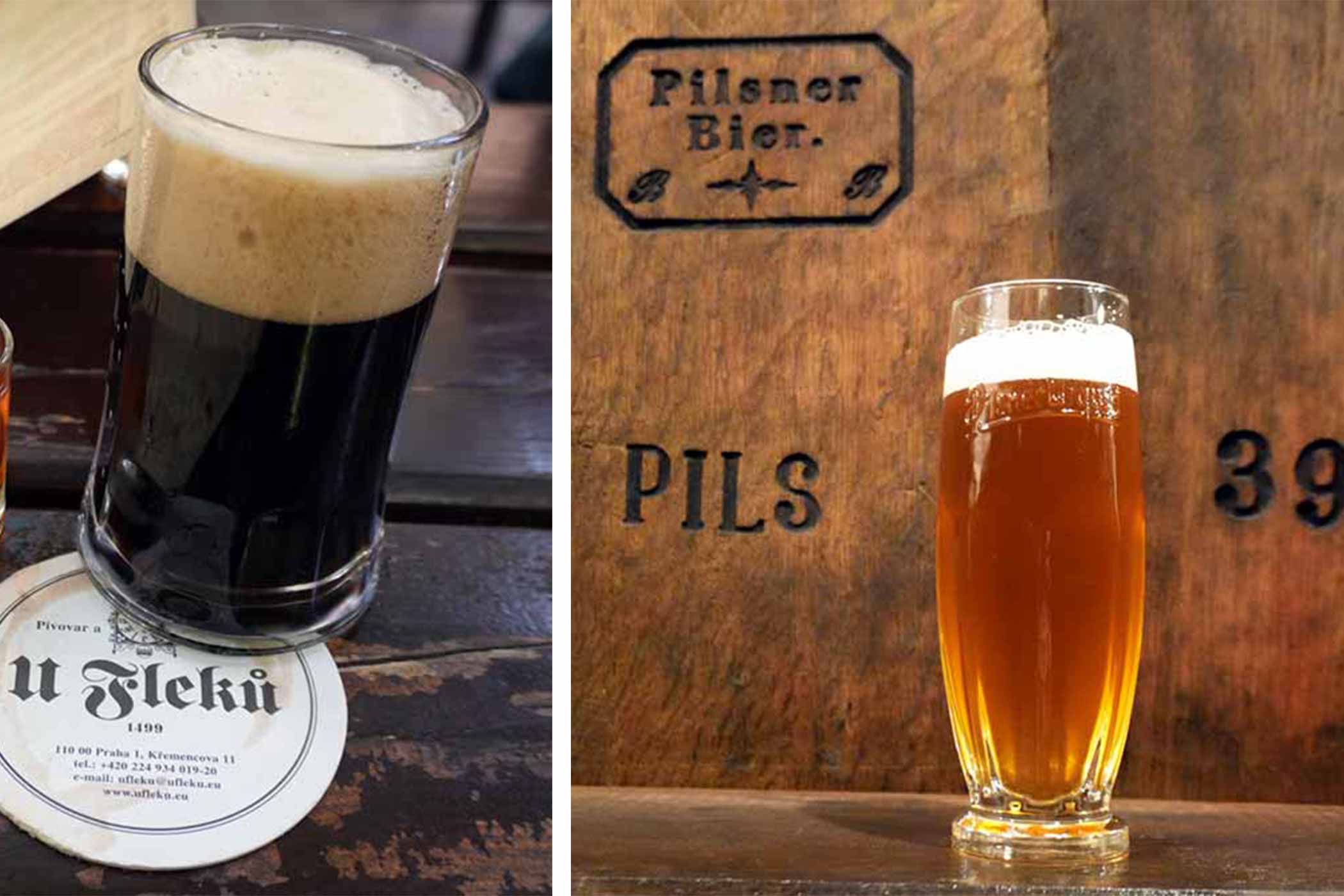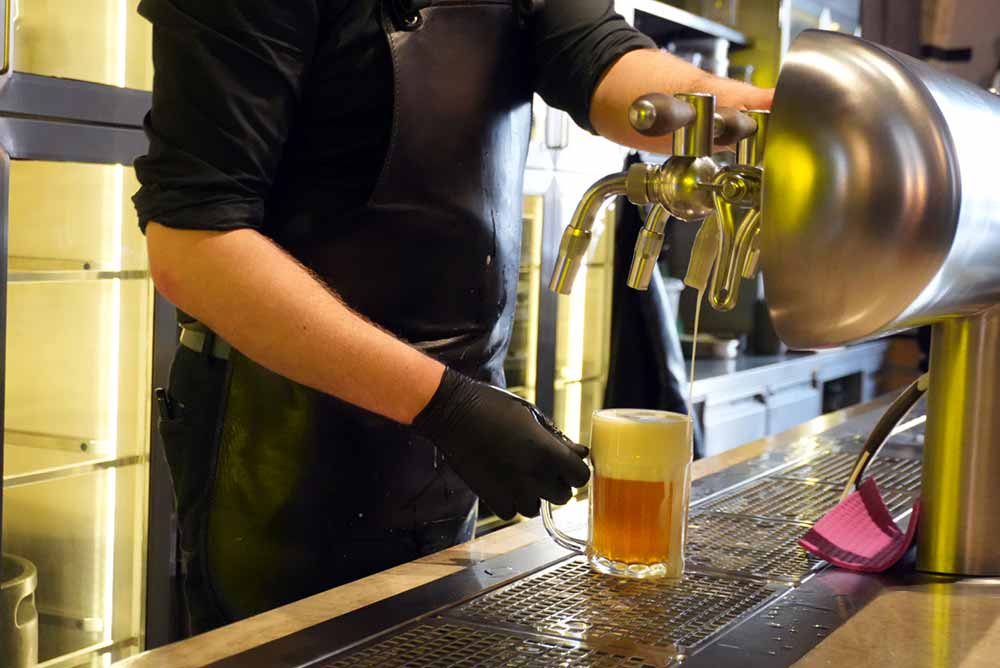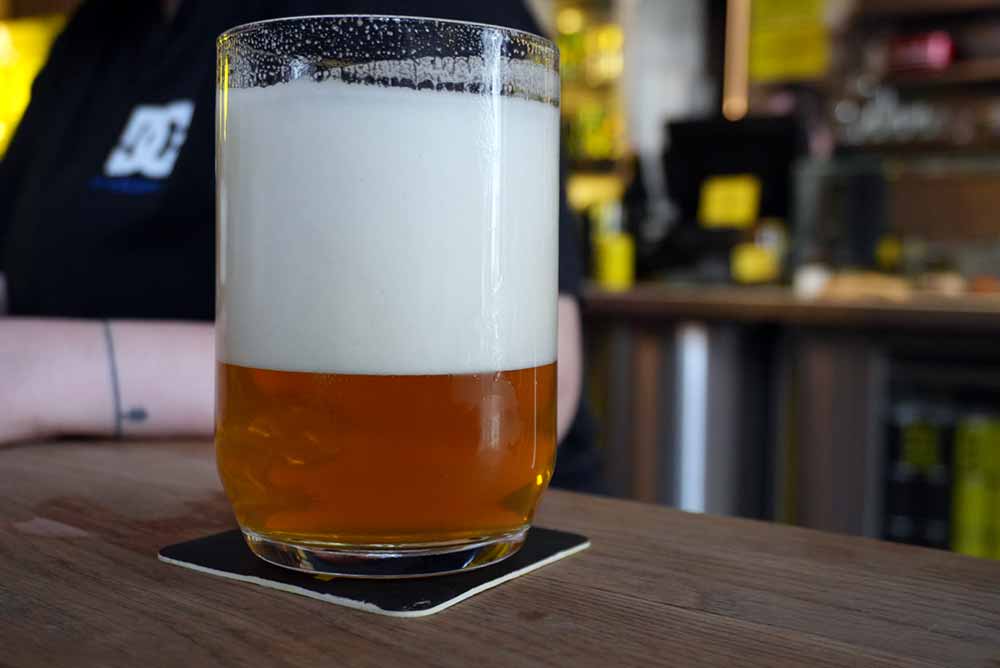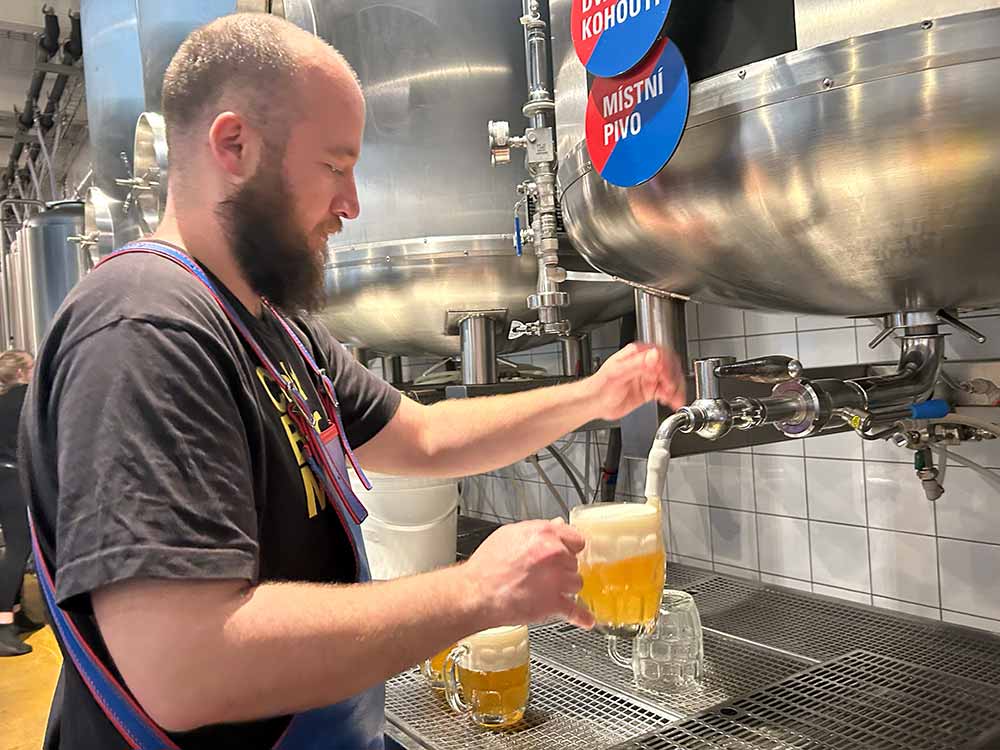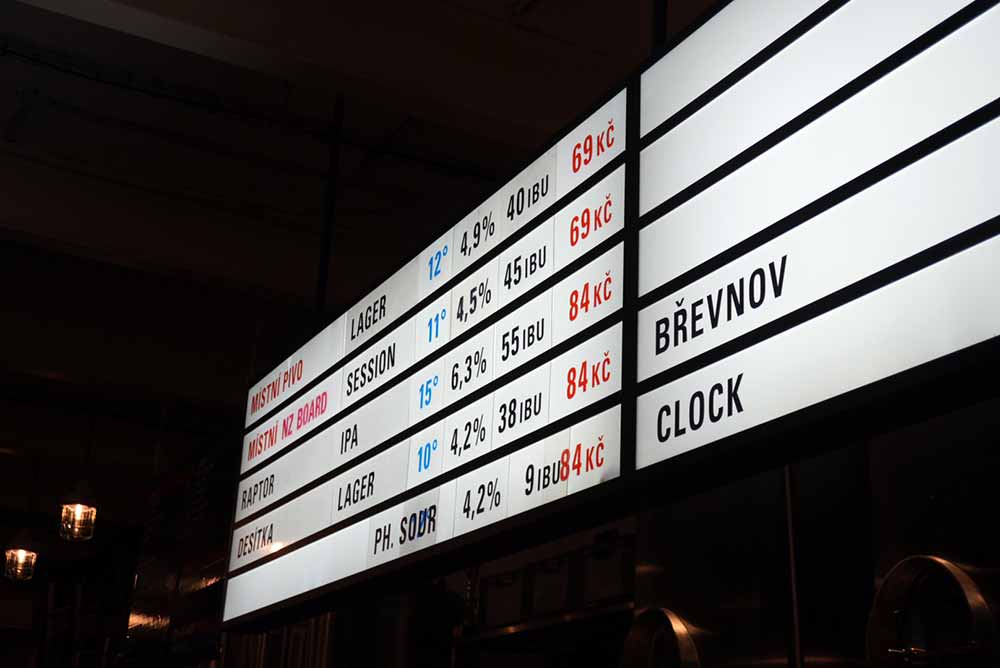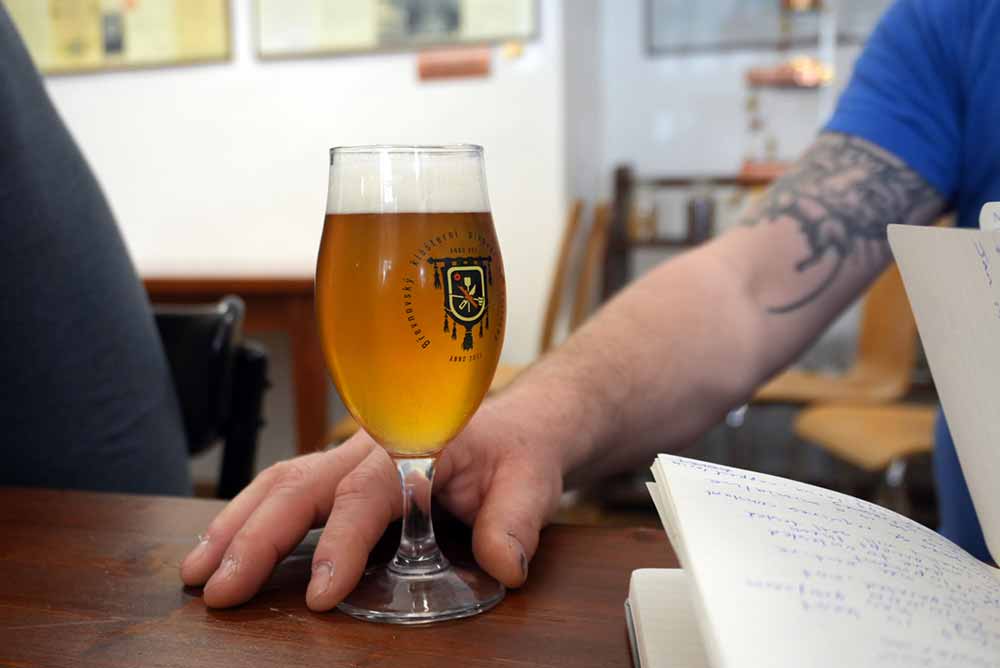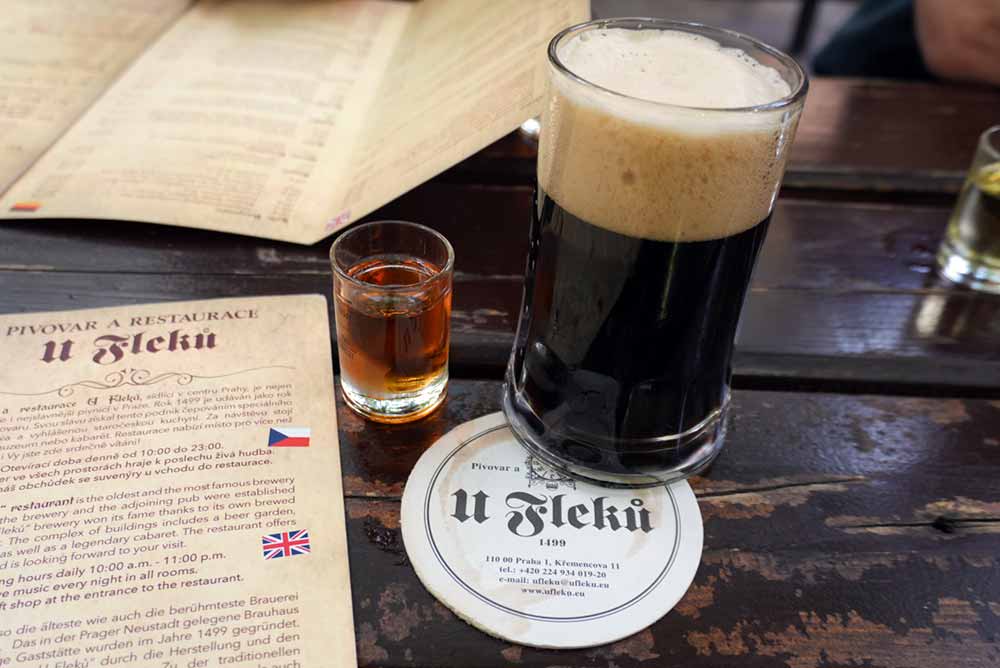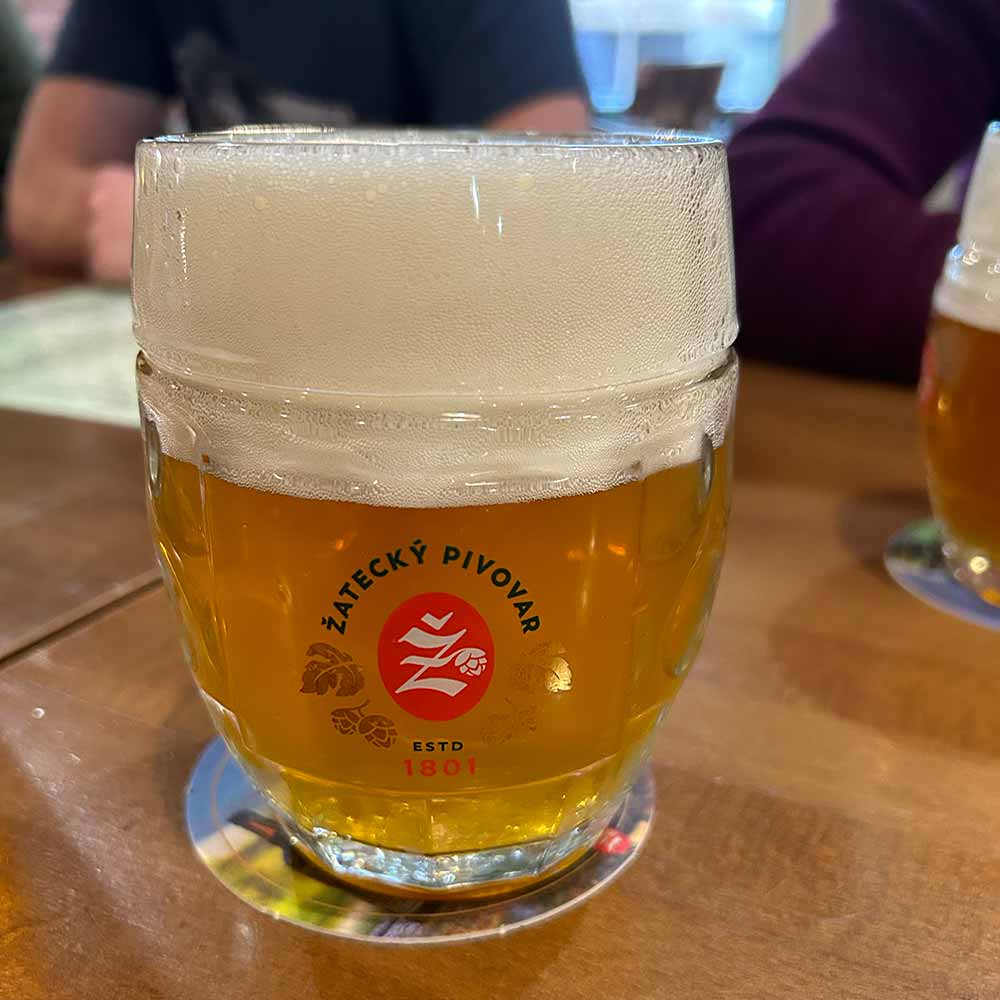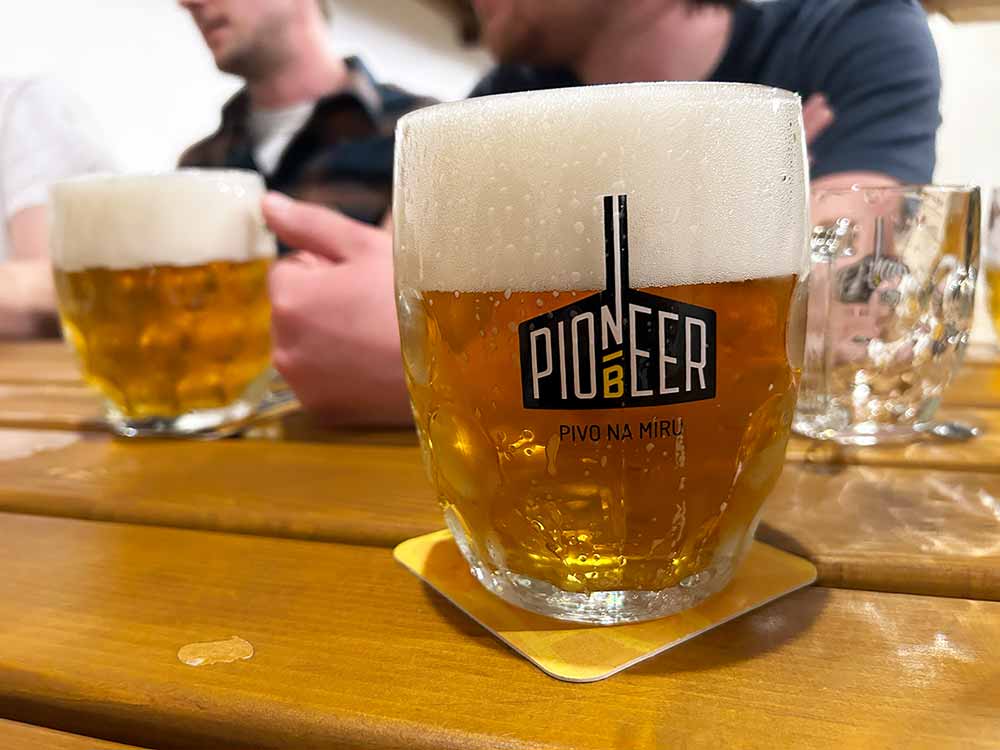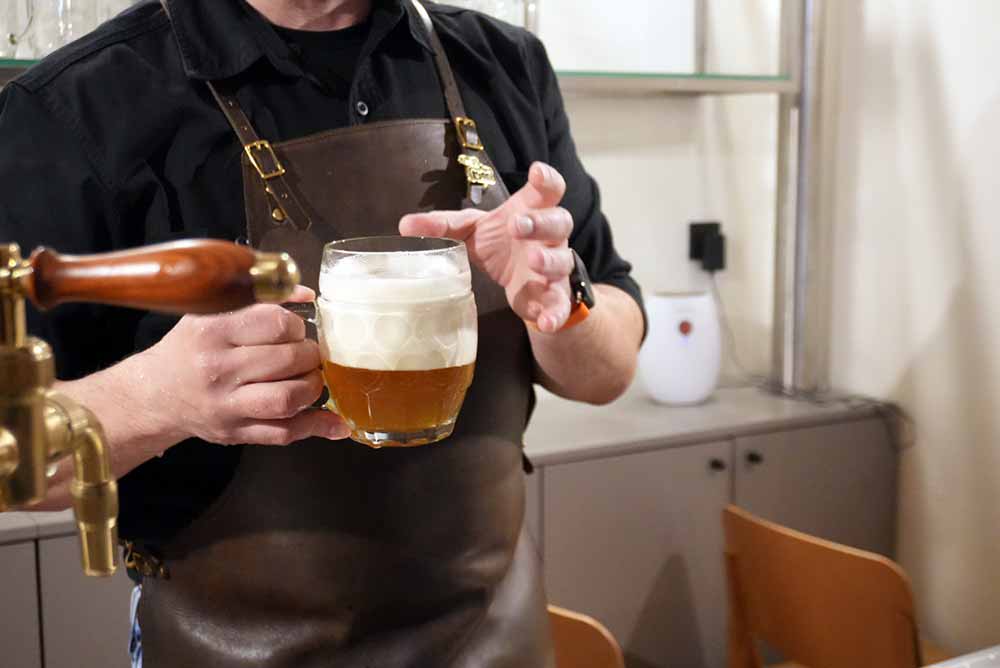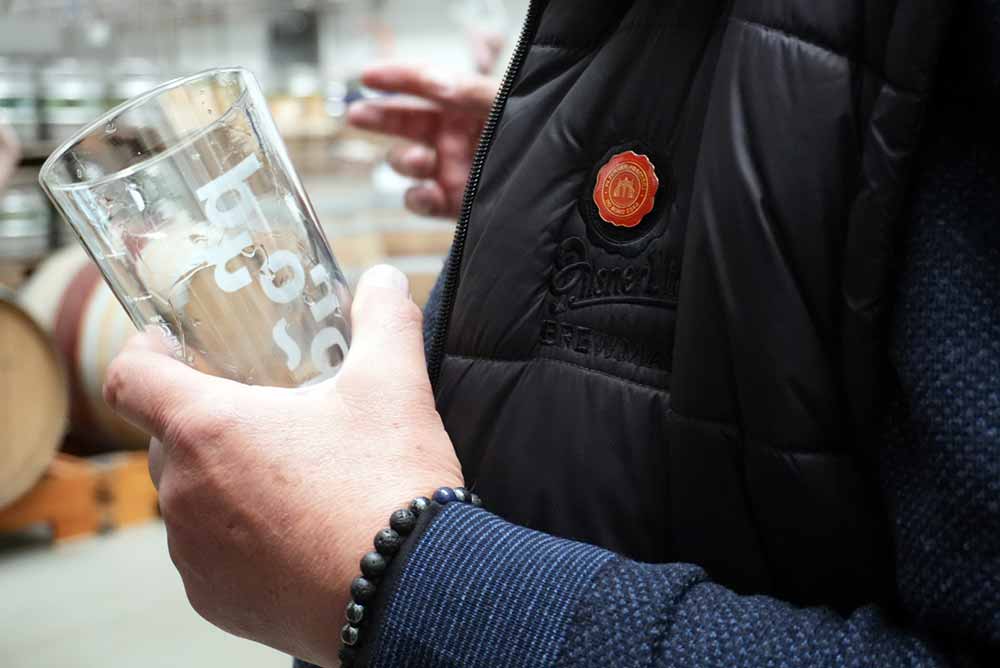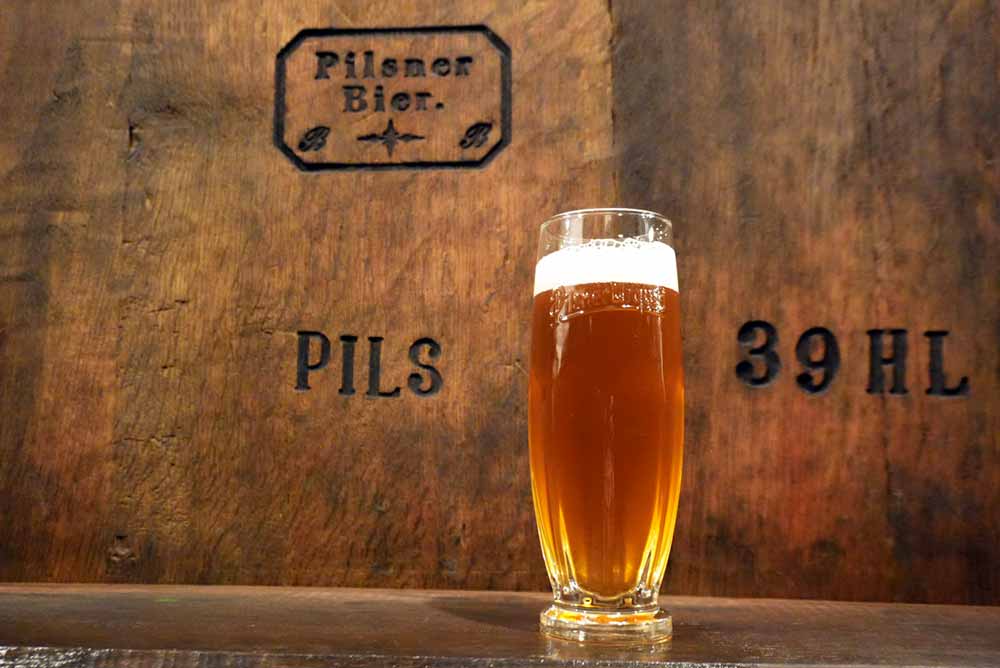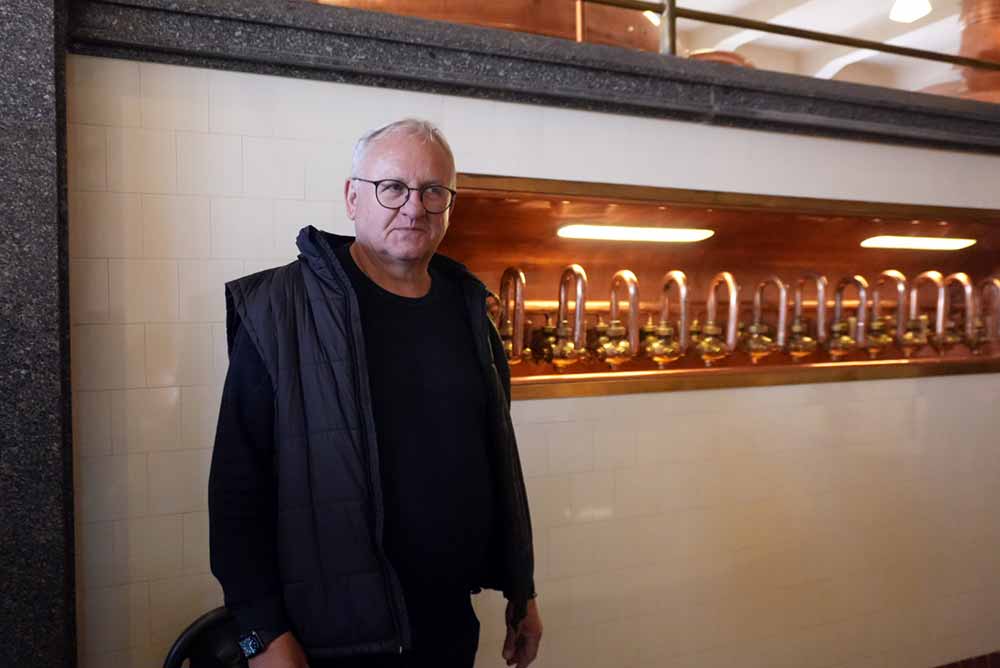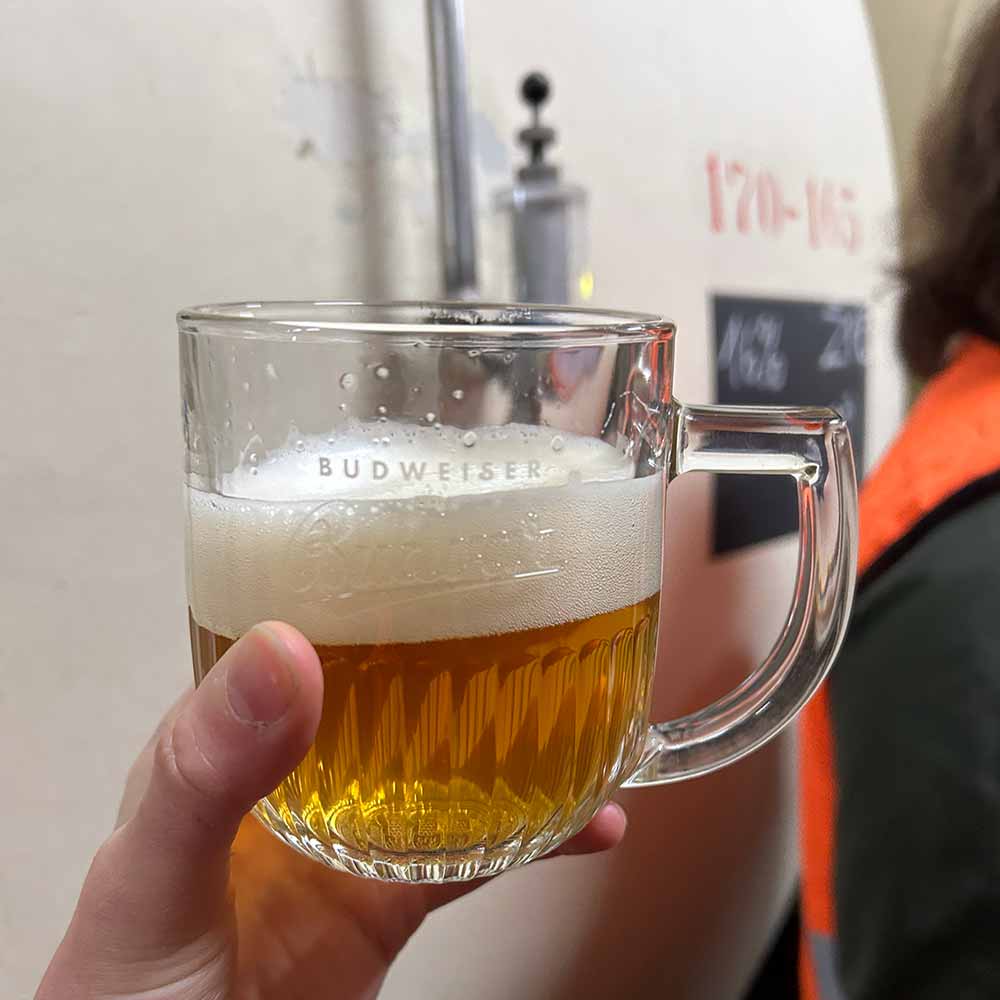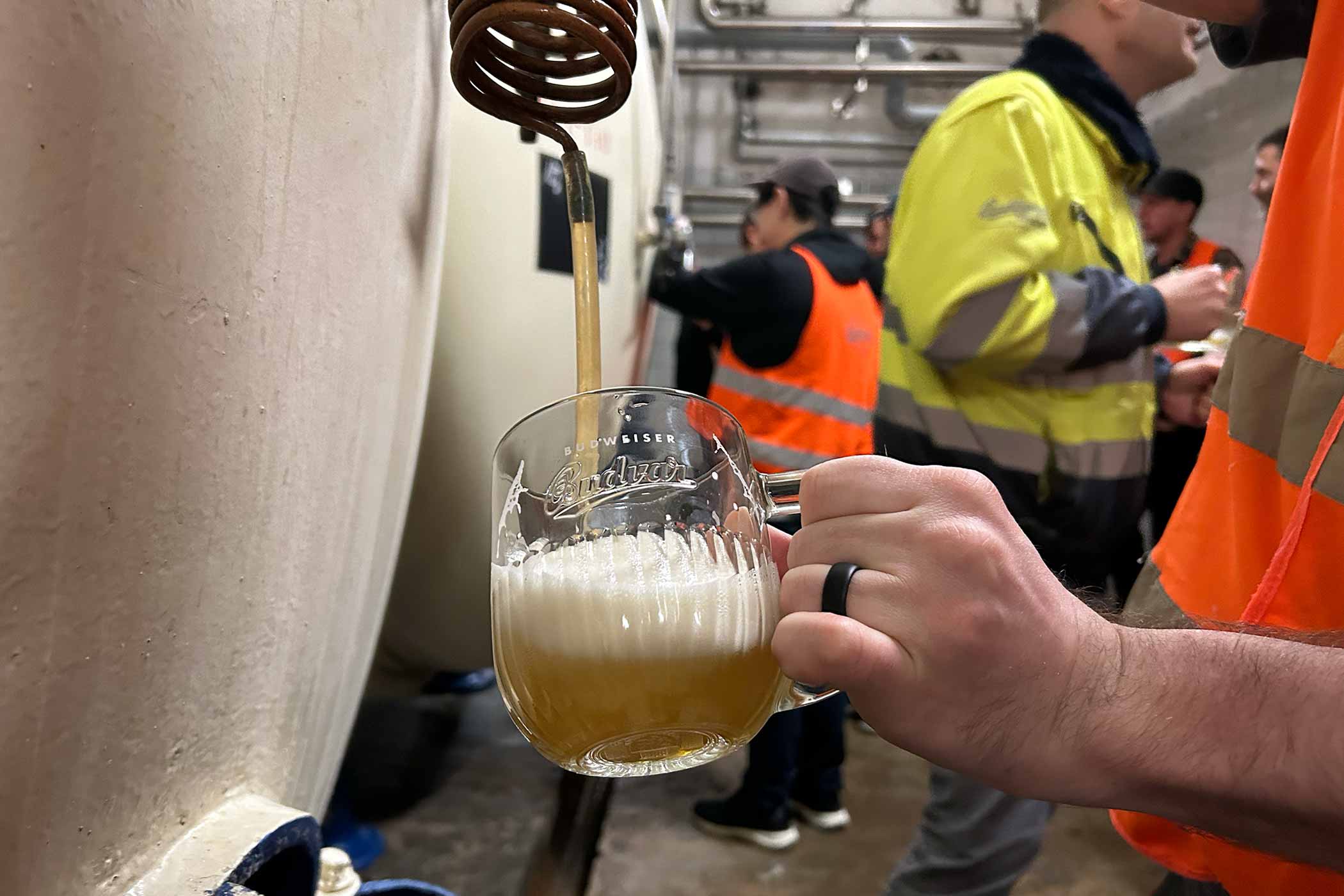Shop
The Top 12 Beers We Drank in June 2024
Czech it out!
Hop Culture's Hottest Stories in June:
Editor’s Note: This is the last in a series of articles created in collaboration with the Czech Ministry of Agriculture that invited Hop Culture to join a group of American and Canadian brewers on a trade mission trip to the country to learn more about Czech brewing and ingredients.
Our Favorite Breweries and Bars to Visit in Czechia
At Goldfinger, Lagers Are a Lifeblood, Literally
A Happy Accident: The History of Timbo Pils and the West Coast Pilsner
Our spring adventures started in April with a visit to theU.K. and Czech Republic, the former of which we covered in last month’s “The Top 12 Beers We Drank in May 2024.”
For this month, we’re sharing all the best beers we drank in Czechia, including…
Unpasteurized, unfiltered Pilsner Urquell straight from the source in the caves beneath the brewhouse.
An electrifying English pale ale from an experimental brewery on Pilsner Urquell’s campus housed in a one-hundred-year-old power generation plant.
Two super secret beers from the cellars of Budějovický Budvar.
The best Czech dark lager we’ve ever had at one of Prague’s smallest breweries but largest restaurants (and beer gardens).
And countless Hladinkas and Šnyts of Czech pale lager from some of the top beer bars in Prague and Plzeň.
A nation known for drinking the most beer per capita in the entire world, the people of Czechia sure know how to drink.
And we certainly tried to do our part.
Here are all the best beers we drank during our incredible time in Czechia.
Editor’s Note: We’re presenting the beers loosely in the order in which we drank them.
Top 12 Beers We Drank in June 2024
H11 – Hendrych
Vrchlabí, Czech Republic
Czech Pale Lager – Our group spent quite a few nights at PULT, an incredible pub part of the Ambiente group of restaurants in Czechia. Walk into the tiny shotgun-style bar, and you’ll find a menu with just six main beers on draft. Uniquely, PULT opens up these spots on their tap list once a year. Those that they choose stay on for the entire 365 days.
For instance, H11 from Hendrych.
I can’t tell you how many Hladinkas (a pour that includes two-thirds beer and one-third of a wet, dense, drinkable foam) of this beer our group drank throughout just a couple of days. Suffice it to say “a lot” will have to do.
Hendrych’s flagship beer has a fair amount of bitterness for a Czech pale lager, but mysteriously, the more you drink it, the more drinkable it becomes. Sounds like a riddle, but it doesn’t have to be.
The beer’s full body and long maturation time in lager tanks ensure this beer crackles with crispiness.
And if you don’t believe me, maybe you’ll believe PULT Tapster Magda Hoppová, who told me she finds Hendrych to be “very drinkable.”
Anežka – Pivovar Clock
Potštejn, Czech Republic
Czech Pale Lager – I will say, though, while most of my co-trippers went to town on Hendrych’s flagship pale lager, I actually latched onto another option on PULT’s tightly managed menu—Pivovar Clocks’ Anežka.
When Hoppová took me to PULT during my first afternoon in Prague, she helped me navigate the menu.
“Do you want something hoppier or maltier?” she asked me.
Maltier, all the way.
Hoppová didn’t steer me wrong. Anežka has a slightly malty sweetness supported by a resinous character that balances everything crisply and cleanly.
PULT’s notes on this beer: “Light golden color and white head, the beer is almost clear. The aroma of Pilsner malt and Žatec hops. Taste medium-bodied, medium bitterness, and a strong taste of Žatec hops.”
Pair a Hladinka of this next to one of PULT’s toasted sandwiches—my favorite was the cheese and jam—and, yeah, you’re set.
Místní Pivo 12° – Dva Kohouti
Prague, Czech Republic
Czech Pale Lager – If we weren’t hanging in PULT’s tiny space, we were sprawling across the massive cobblestoned beer garden of its sister pub, Dva Kohouti.
Every single person I talked to before this trip, whether they’d been on the mission before or simply traveled through Prague, told me I could not leave the country without going here.
It’s easy to see why.
Like any pub the Ambiente group operates, they give unparalleled care to their beer.
If you walk in when they’re not busy, you’ll find a tapster washing glasses. If you walk in when they are busy, like a seven-hour line out the door on a Monday afternoon, you’ll find a tapster washing glasses.
The rules are followed to a T here—glasses sit chilling in a cold water bath, each cleaned before being expertly poured. (Need a refresher on how this group likes to pour beer? Check out our guide to the proper Czech pours.)
The go-to here?
Místní Pivo 12°, the pub’s flagship Czech pale lager. It’s the one beer you’ll probably find on tap all the time.
Starting with Pilsen and Munich malt, this beer goes through a two-step mash process before hopping with Žatec Saaz semi-early red wine and Saaz Special.
Finishing a bit lighter at twelve degrees and 4.9% ABV, Místní Pivo 12° is just the perfect beer to crush again and again sitting outside at one of those long picnic tables in Dva Kohouti’s beer garden.
Desítka – Pivovar Matuška
Broumy, Czech Republic
Czech Pale Lager – If you’re not drinking Místní Pivo 12° at Dva Kohouti, and you see Desítka on tap, go for it. When I first had it, I wrote in my notes that this was one of my favorite beers of the trip so far. In reality, this was night one. Early days, indeed.
Funny how when I look back through my chicken scratch, I’d write that phrase seemingly after every new beer I tried. ????♀️
So, you may call it snap judgment, but I stand by my call.
Pilsner and Carapils malt combined with Czech Saaz Special hops from Žatec make this beer seem very simple, but it has a complex layer of flavor.
You get a bite of bitterness washed quickly away into a thirst-quenching pale lager. As you often find in Czechia, this is a beer you can really crush.
Benedict Světlý Ležák 12% – Břevnovský klášterní pivovar sv. Vojtěcha (Břevnov Monastery Brewery of St. Adalbert)
Prague, Czech Republic
Czech Pale Lager – As we sat at Břevnov Monastery Brewery of St. Adalbert, a brewery founded in 993, beer journalist Evan Rail joked, “This one is old!”
Clustered around two long tables, we passed around a weathered, almost leather-looking jug full of the monastery brewery’s Czech pale lager, Benedict Světlý Ležák 12%. Rail told us this is one of his top five favorite beers.
The beer starts with Moravian Czech pale malt barley, which, uniquely, isn’t floor-malted but comes from a mechanized maltster in Nymburk.
But what truly sets apart this beer are the hops.
When I asked Rail what made this one of his favorites, he responded, “It just has a special taste. I like it.”
He adds the Saaz hops have a unique flavor here, “like ginger or chewing on a cinnamon stick, woody and spicy.”
For much of the monastic brewery’s history, they sourced hops from an abandoned Saaz hop yard owned by a friend of the brewery in the Saaz region.
The over seventy-year-old hop bines produced those aforementioned characteristics. Today, the Benedictine monastery actually has its own Saaz-producing hop yard, which grows forty percent of the Benedictine Saaz used in its beers.
In their světlý ležák, Břevnov also adds Magnum hop extract because the Benedictine Saaz has only 1.9 percent alpha acids; they need the Magnum oil for a touch more bitterness.
A double decoction adds a nice body, color, balance, and drinkability to the beer. As Rail shared more about the history of Czech beer culture, it wasn’t uncommon for our group to refill glasses again and again and again.
Editor’s Note: If you’re looking for a full breakdown of this beer, we highly recommend checking out Rail’s piece in Craft Beer & Brewing.
A favorite for its flavor and drinkability, but also, we think, for a touch of alluring history!
Flekovský Tmavý Ležák 13° – Pivovar U Fleků
Prague, Czech Republic
Czech Dark Lager – At most places in Czechia Czech dark lager won’t be the most popular beer on the menu. But without a doubt, the only one you need to drink is Pivovar U Fleků’s Flekovský Tmavý Ležák 13°.
This is by far and away the best Czech dark lager I’ve ever had. And I’ve tried lots of excellent versions here in the States.
U Fleků has just perfected this recipe over time. Lots and lots of time.
One of the smallest private breweries (yet the largest restaurant) in Prague, U Fleků originally started as a brewery over half a millennium ago in 1499 and has been brewing ever since. Started by Vít Skřemenec, the building shifted hands a few times and survived a few wars until finding its way to Jakub Flekovský, who bought it in 1762, giving the brewery its current name—U Fleků.
This brewery has become known for one beer—tmavé pivo (Czech dark lager)—which it has brewed for over 180 years.
Using a 140-year-old mill, U Fleků grinds their own combination and proportions of roasted dark and light malt, which they assured us is a secret known only to the current family. But after just a little research, we found the beer includes fifty percent pilsner malt, thirty percent Munich, fifteen percent caramel (toffee), and five percent dark roasted malt.
The milled malt then goes to the mash tun, where it’s mixed with water at 52° C before going through a double decoction.
After adding Saaz hops, the beer cools in a coolship before fermenting for thirteen days and lagering for up to six weeks.
The 13° dark lager should have an ABV above five percent (the degree refers to the strength and gravity of the beer pre-fermentation). But U Fleků lists this beer at 4.6% ABV, meaning the brewery under-attenuates the dark lager, leaving behind unfermented sugar that gives this beer its uber creamy, red-carpet-smooth mouthfeel.
This Czech dark lager looks like perfectly tempered chocolate with the perfect shine and viscosity.
As you drink your way down the mug, it’s like you’re popping a few different truffles into your mouth—milk, dark, white, and ruby chocolate.
This beer is a magic trick—sweet, but not too sweet; roasty, but not too roasty; looks heavy, but drinks like a silky dream.
Nothing out of whack, light and not too malty, Flekovský Tmavý Ležák 13° is a beautiful beer to drink in U Fleků’s epic beer garden.
And in terms of beers I’m still dreaming about which surprised me the most, this tops the charts.
Chrámový Samec 11 – Pivovar U Orloje
Žatec, Czech Republic
Czech Pale Lager – After a day spent visiting hop producers such as Bohemia Hop and Top Hop in Žatec, a region of Czechia well known for growing varieties such as Saaz, our group grabbed dinner at Pivovar U Orloje.
Right in the center of Žatec, Pivovar U Orloje opened in 2012 as a tribute to the hop growers in the area, offering beers flush with local hops.
Chrámový Samec 11 was a consensus favorite around the table, with mugs of Hladinka pours refilled three, sometimes four, times throughout the meal.
This particular Czech pale lager hit first with a distinct fruitiness, almost like a bubblegum-type hefeweizen characteristic.
Super smooth and crisp, Chrámový Samec 11 also had a distinct maltiness in the background that rounded out everything.
COMFORT – Pioneer Beer
Žatec, Czech Republic
Czech Pale Lager – A pretty modern brewery that only opened in 2018, Pioneer represents the craft beer wave in Czechia.
Situated in a former hop warehouse in Žatec, Pioneer is absolutely gorgeous inside.
Walk in, and you’ll immediately notice gleaming silver tanks set into the floor. A tiny set of taps pours fresh beer, from the classic to the contemporary.
Pioneer represents a mashing of tradition and innovation. Right alongside lagers like Pioneer’s well-known Rezident, you’ll also find a smattering of more modern American styles, including hazies, DDH IPAs, and even a Cold IPA.
I suppose I kept it classy (because, you know, I can get the hazy and hoppy stuff back home) for the COMFORT, a single-hop Czech pale lager featuring Saaz Comfort, a mildly bitter variation on Saaz.
The beer’s elegant balance of hops and malt had me returning not once but twice. I think that says it all.
Světlý Ležák – Pivovar Purkmistr
Plzeň, Czech Republic
Czech Pale Lager – Undoubtedly, one of the trip’s highlights was visiting LUKR, the company responsible for a side-pull faucet that has appeared at many breweries worldwide.
LUKR Global Sales Manager Jan Havránek took us back into the workshop, showing us where they make the goods. Later, in a small room set up as a classroom of sorts for LUKR’s Perfect Pour Academy, LUKR Head Tapster and 2022 Pilsner Urquell Master Bartender Ondřej Rozsypal gave us a demonstration on what they consider the different proper Czech pours.
As he capped off a two-thirds head of foam on a perfectly poured Hladinka in a Czech dimpled mug, he set the jug down on the stainless steel table, asking who would like to step up and taste the beer. It just so happened I was right in the front. (Don’t worry; everyone eventually got a beer.)
Bringing the cold mug to my lips, Rozsypal instructed me to take a healthy swig, drinking through the wet, creamy, dense foam into the liquid underneath.
The almost silken-tofu creaminess in the foam gave way to a bright, electric beer alive underneath. That’s the best way I can describe it.
Crisp, clean, clear, and refreshing with maybe a hint of lemon-lime Sprite spritz.
Honestly, this beer wasn’t trying to be anything more than it was—an excellent Czech pale lager.
I followed up with Havránek later, asking what we actually drank. He told me they work with Pivovar Purkmistr to bring in their Světlý Ležák.
The brewery calls this a classic pale lager brewed using a double mash process and the best handmade Moravian malts and Saaz hops.
Until then, many in our group agreed this was the best beer we’d tasted all trip (of course, we hadn’t gone to Pivovar Proud, Pilsner Urquell, or Budvar yet, and as I’m sure you’ve learned by now, we made this claim many times!).
Regardless, the beer’s quality was a testament not just to Pivovar Purkmistr but also to the way Rozsypal, the tapster at LUKR, expertly poured it.
You see, the Czechs have a saying that translates to something like this: The brewer brews the beer, but the tapster makes it. How a tapster takes care of the beer once it’s left the brewery will determine whether it reaches your lips in peak condition or not. And those drinkers will be the ultimate judge of taste and quality.
In LUKR and Purkmistr’s case, we judge this beer to be top-notch.
Wondering what we’re talking about? Tap below for our full story on the “Life of a Tapster.”
Ventill – Pivovar Proud (Elektrárna)*
Plzeň, Czech Republic
Czech Pale Lager – Close to LUKR in Plzeň, you’ll find Plzeňský Prazdroj, aka Pilsner Urquell. When we visited, a white-haired man with a cherubic face and black thin-rimmed glasses greeted us. Over his navy long-sleeve waffle knit, a light black vest with the words “Pilsner Urquell Brewmaster” stamped over his heart. Václav Berka, the thirteenth brewmaster at Pilsner Urquell, joined a lineage stretching back to Josef Groll, the man who literally invented the pilsner in the mid-1800s.
The now-retired Berka shepherded our group of twenty brewers from across the U.S. and Canada onto a bus. We hung on as we bumped down a cobblestone road, past the yellow building stamped with Pilsner Urquell, past the pub crowded with drinkers sporting mugs of pale gold liquid, past the courtyard that Berka assured us is filled in the summer with those dancing and drinking.
The bus kept going. And we didn’t know where.
It certainly wasn’t into the brewhouse and caves of Pilsner Urquell, one of the world’s most well-known breweries, which produces a beer drank more than any other in Czechia.
Instead, we pulled up to an unassuming building with a brick smokestack towering into the sky. In front, polished gleaming steel kegs with a blue band and letters pulsing like an electric current: Proud.
As we crowded beside Berka, a petite woman with curly black hair appeared at his side. She tied a jacket around her waist over a blue Proud polo.
Lenka Straková has been the brewmaster at Pivovar Proud for the last three years. Here on the Pilsner Urquell grounds, she and her team make new, experimental beers meant to test the market, electrify the palates of Czech beer drinkers, and push their beer boundaries to new heights.
For a minute, Straková disappeared, strolling to the fermenters in the back with a large, empty pitcher. When she returned, the pitcher looked invitingly full with a clear, gold liquid. Hands grabbed tall glasses decorated with “Proud” as Straková flitted from person to person, filling their cup.
“If you want to be a good brewer in Czechia, you have to brew a good pale lager,” Straková said with a chuckle. “And honestly, as we are a part of Pilsner Urquell, I wanted to have our lager as close to that as possible.”
Of course, Straková quickly emphasizes she cannot copy Pilsner Urquell, nor does she want to, “but we can be very close raw material-wise.”
That’s Ventill. Similar to Pilsner Urquell, this Czech pale lager starts with the same base—only pale malt from the Pilsner Urquell malt house plus a small portion of caramel malt to increase the golden color.
The hops remain the same, too—Czech Saaz, because “Saaz hops are just the best,” says Straková, who adds the hops four different times—forty percent at the beginning of the boil for bitterness, twenty percent in the middle, and forty percent at the end for what she calls the “fine aroma.” Lastly, a fifty g/hl dose goes into the whirlpool for aroma and a tiny bit of bittering.
It’s all a balancing act. “Too many hops in the whirlpool can have a higher aroma but be harsh, while too much addition at the beginning can be astringent with no aroma at the end,” she explains. “It’s all about executing different ratios added during the boil.”
Production-wise, Pilsner Urquell typically goes through a triple decoction, but Ventill only gets double decocted because Proud has a totally different system—steam-powered instead of direct flame.
During fermentation, Straková uses a W-34/70 yeast strain from Weihenstephan in Germany. She feels this strain cleans up the beer and does a great job of preventing the presence of diacetyl, which she doesn’t want here.
Named after the Czech word for the piece in the brewhouse that opens a valve on a steam line to heat something, Ventill is “the heart of our portfolio,” says Straková, noting it’s the top seller. “If we are brewing on steam, this power is the heart of our brewhouse, and the Czech lager is the same in the brewery.”
Straková says they didn’t plan for this beer to sell the most, but she’s not surprised it happened naturally.
No doubt about it, Ventill is the heart of Proud and a pretty damn fine beer.
**Editor’s Note: Some time after our visit, Pivovar Proud rebranded as Elektrárna. For our experience, while we were there all of the equipment was branded with the Proud name and everyone we talked to at Pilsner Urquell referred to the brewery as Pivovar Proud, so we will continue to use that name in this piece.
Pilsner Urquell – Plzeňský Prazdroj
Plzeň, Czech Republic
Every year, more than half a million visitors travel worldwide to Plzeň just to visit Pilsner Urquell to taste of the world’s most iconic unfiltered, unpasteurized pilsner.
Call it a pilgrimage. Call it a religious experience. Walking under those cream and tan arches stamped with MDCCCXLII and MDCCCXCII (1842-1892) makes you feel like you’re on hallowed ground.
Which, if you love pilsner, you technically are.
Here, the German brewer Josef Groll brought a new type of yeast to Plzeň. Combined with the city’s uniquely soft water, malt from their own malting plant, and Saaz hops grown not too far away, he created a unique new beer. The first pilsner left Pilsner Urquell on October 5th, 1842.
When Groll opened the first barrel on November 11th during a holiday celebrating at a big fair in the town square, people were shocked, as Berka tells it. Instead of finding a dark, cloudy beer popular then, Groll raised a glass full of this golden, clear beer with a nice, foamy head.
People loved it, and the pilsner soon grew in popularity, popping up in Prague, Vienna, London, Paris, and even America over the next thirty years.
Now retired, Berka served as our tour guide for the day.
We started in the brew hall with its massive direct-fire copper kettles, traditionally fueled by wood, then coal, and natural gas today.
Pilsner Urquell believes the copper kettles produce the basic parameters for pilsner. A triple decoction creates sugars that caramelize on the walls of the copper kettle, giving the beer its characteristic golden color and caramel flavor and aroma, along with a low-modified Czech Moravian barley and a special mix that has about five to six varieties.
As he showed us around, We peppered him with questions.
How many beers have you drunk here?
How many Pilsner Urquells do you drink in a year?
“I already answered this,” Berka said with a sly smile. “I am very bad at math.”
As we make our way down into the underground aging caves to what he calls “the place where pilsner was born,” he encourages us to touch the walls and the floor and feel the history.
“I hope I will die here,” he says, half joking. In fact, Berka grew up here. Berka’s father worked in the fermentation department, and as a kid, Berka would spend time in the nine kilometers of cold cellars and underground tunnels.
He says if you ever get lost and cannot make it back to the gate, “just follow the water.” The condensation on the walls drops into gutters that flow down towards the way out.
The average temperature of the cellars sits at five to six degrees Celsius. In the past, blocks of ice were brought in from local rivers to make the area even colder for maturation.
Following history, Berka says they still ferment Pilsner Urquell in wooden casks and mature the beer in wooden oak barrels to achieve its famous drinkability.
We grabbed a taste of the unpasteurized, unfiltered Pilsner Urquell right off one of these wooden barrels. Again, drinking it in the chilly cellars was almost a religious experience.
Drinkability is the word that keeps popping up like a cartoon thought bubble above our heads. You pick up a pinch of that caramel sweetness from the copper kettles and triple decoction Berka spoke of in the brew hall, followed quickly by a refreshing effervescence from the natural carbonation. Everything washes down with a snappiness from the Saaz hops. The wet foam on top locks in all that flavor and aroma, ensuring that the next sip will be just as good as the first.
Is it too much to say that we emerge from Pilsner Urquell’s caves changed drinkers?
Zasr Hop Celebration – Budějovický Budvar
České Budějovice, Czech Republic
Fresh-Hop Lagers – Rivaling Pilsner Urquell in size and popularity, Budějovický Budvar has its own 130-year-old way of making its premium lager—Budweiser Budvar.
Adam Brož, Budvar’s tenth brewmaster, met us at the start of the tour. In a neon yellow jacket with black stripes, grey dress pants, and a paisley cream shirt underneath, Brož seemed to smile every time he talked. He was genuinely excited to show us around the brewery he has captained for the last fifteen years, from the brew hall with its gleaming half-copper, half-stainless steel kettles down to the cellars.
As Brož led us through echoing underground halls to get a taste of Budvar’s premium lager right off the tanks, we passed another room. Its cream doors ajar, the empty cellar tempted us to peek inside.
“We will have time enough to be in this room,” Brož said with a sly smile. “Because [the tanks in there] are the secret.”
Brož eventually shared two “secret” beers in those tanks, a series of fresh-hop experiments he’s run at Budvar since 2012 that you won’t find anywhere else.
After attending the World Brewing Congress in Portland, OR, Brož and his colleagues noticed American brewers’ incredible affinity for hops.
“We felt the enthusiasm to celebrate the beauty of the hops,” he shared.
So over dinner, they hatched a plan—combine the American attitude towards hops with the Czech history of making lager.
Returning to Czechia, Brož and his team brewed a fresh hop beer with 400 kilos of Zasr (Saaz) fine aroma hops collected from a hop yard in Usplavu and personally trucked 200 km back to the brewery.
Back at Budvar, the recipe starts like Budweiser Budvar, with only pale malt and a double decoction. Even the first two doses of hops remain the same, but with the third dose, things veer quickly. Typically, Brož would add the last dose a half hour before the end of the ninety-minute boil, but here, he adds them ten minutes before the boil. Since they’re using fresh hops, not the pressed cones as is standard for Budweiser Budvar, he says there is no need for the hops to disintegrate.
From there, the fresh hop beer, which doesn’t technically have a name (but Brož came up with one for me on the spot—Zasr Hop Celebration), ferments at a temperature that never exceeds 11° C for about fifteen days. This follows the process for the OG premium lager, but for maturation, again, we veer.
Zasr Hop Celebration matures for up to 400 days, reaching 16° Plato. Brož and his team start tasting it at two-week intervals after eighty days in the cellar.
“The first brew was so thrilling because the taste of the hops was really recognizable,” said Brož. “The tradition began.”
Each year since, during hop harvest, Brož collects fresh Zasr hops for what he calls a “technological experiment.”
Brewing the fresh-hop beer never gets old because he finds the taste constantly changing. “It’s really amazing. Sometimes you feel the fruits; sometimes you feel the honey; sometimes you feel the strawberries,” he shared with our group as we elbowed each other out of the way to pull a pint off the pigtail. “What’s on today?”
This beer fascinated our group. Today, it seemed to drink with a fresh strawberry sweetness, like strawberry shortcake, with a clean, wet finish.
The buzz audibly rose as we huddled in the narrow space in front of the slightly rusting tanks. People crowded around Brož, firing off questions to him.
With each answer, his one-hundred-watt smile shone a little brighter.
To him, this was the whole point of the experiment: a cyclical melding of two enthusiastic and inspiring beer cultures.
“When the brewers came into our brewery, I always tested the beer with them. I think that we always have the most vivid discussion with the brewers when they try the tank of this beer because we are sharing not only the experience with this beer in the small area between the tanks, but it always opens the attitudes of the brewers to each other,” said Brož. “The atmosphere is always the same after several sips with the brewers!”
Budvar On-Trade Quality Manager and Tapster Alexandr Vitek explained that only some people can try these beers. Not shared with the public, these fresh-hop experiments only come out when close business partners or special guests visit. “The fresh-hop one, you can’t get outside the brewery,” he said. “You either have to be a visitor, or you need to work here.”
We felt genuinely awed to share this experience with Brož.
One word kept coming back to both of us. “I think that ‘harmony’ is the most frequent word I have used for these beers in my career,” he said with a grin. “I love these moments. They are quite rare … but I am glad for these rare moments [because] I feel the sharing of the joy of brewing.”
Us too, Brož, us too!

